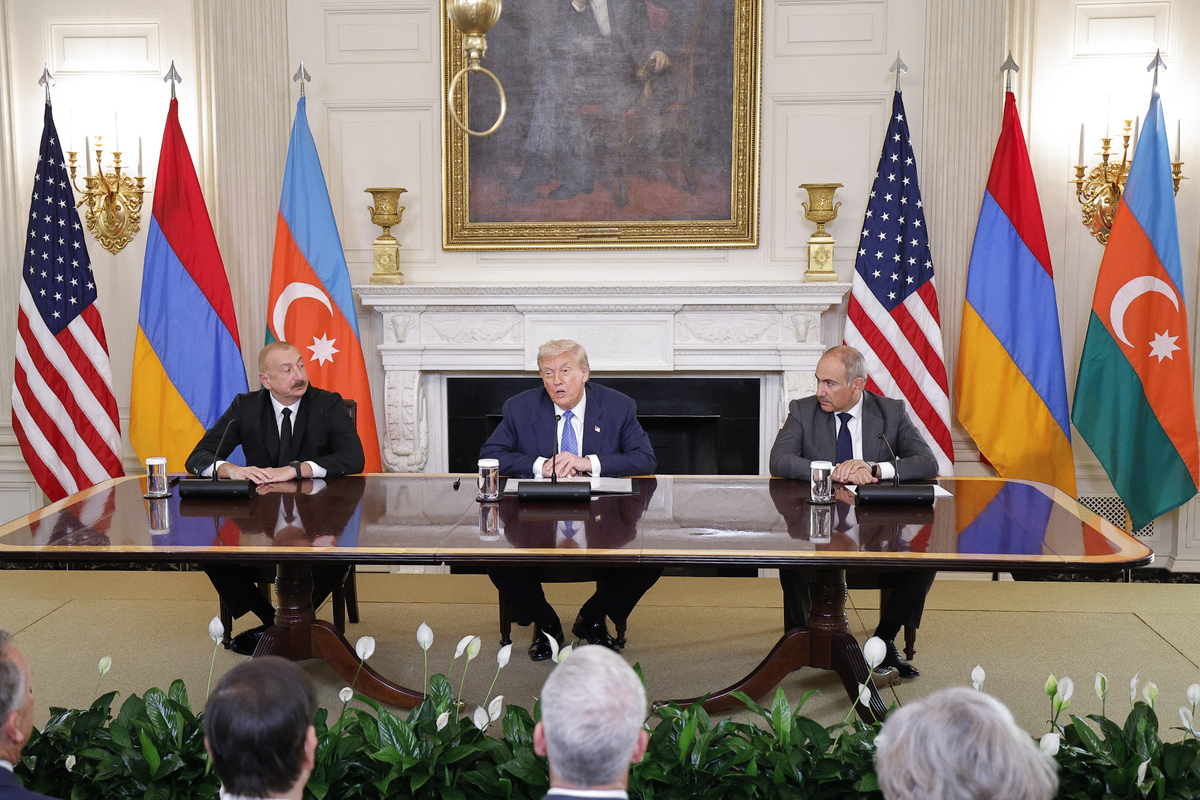Aliyev’s dream and Pashinyan’s signature: What is behind the “Trump Route”?
11.09
2025
For a month now, social media has been flooded with analyses of the well-known agreement signed on Aug․ 8 in Washington between Armenia, Azerbaijan, and the United States, also referred to as the Trump Route.
At this stage, the success of a multi-layered peace process is unrealistic for a simple reason: the purpose of this process is a ceasefire, and Azerbaijan needs a legally capitulated Armenia and Armenian people so that Armenians will never consider pursuing their national-state objectives. In other words, Azerbaijan seeks an unimpeded corridor, a defenseless Armenia without weapons, with a changed Constitution, and a dependent economy and security—nothing more. This process is not called “peace”; it is unilateral capitulation. The Armenian government packages all of this as a sovereignty achievement, branding anyone who disagrees as an enemy of the state to be jailed, silenced, and punished. Meanwhile, what occurs in real politics is far deeper, full of high risks, and far from strengthening Armenia’s sovereignty, preventing territorial losses, or restoring territorial integrity at this time.
Conflicts in neighboring regions remain hot, and at any moment could reach Armenia, although the announcement of the Trump Route—which in my view could not have occurred without tacit consensus with Iran and Russia—temporarily curbed the political appetites of Turkey and Azerbaijan. The Trump Route is merely a statement, an empty project meant to improve President Trump’s international image and potentially help him win a Nobel Prize. The only positive outcome for us is temporarily removing the threat of war from Syunik; everything else—from the Pashinyan-Aliyev signed documents to the 17-point declaration—is empty words. The U.S. will not invest $5 billion and hand the region over to Turks or Russians, nor will Iran or Russia simply watch as Pashinyan prepares the ground for their expulsion from this region. Western powers are skilled in diplomacy: there are easier ways to occupy Turkey, such as Syria, Iraq, and other states where Ankara’s interests might conflict with Washington’s or Moscow’s vital strategic interests.
Meanwhile, the Armenian authorities claim that their multilateral diplomatic efforts have prevented Azerbaijan from taking military action against Armenia, attempting to portray Baku as obstructing the peace process, even though Azerbaijan speaks with opposite rhetoric.
Now, Turkey and Azerbaijan continue to call the route the “Zangezur Corridor,” while Armenia’s prime minister frames it as a major step in the context of the Crossroads of Peace. Meanwhile, the U.S. president even confused the names of Armenia and Albania, highlighting the seriousness of the process. Since Aug. 8, senior Turkish and Azerbaijani officials have mentioned the “corridor” 16 times, amplifying it in global media to publicize and normalize Azerbaijan’s plans for the eventual annexation of Syunik. While Armenian authorities try to conceal this, Ilham Aliyev repeatedly speaks openly about the unimpeded route—i.e., the corridor agreement reached with Pashinyan—most recently on Al-Arabiya TV, with an audience of 300 million. Azerbaijani and Turkish officials regularly state that an agreement exists, but Armenia continues to obstruct or delay its implementation. The latest mention of the unobstructed Syunik route came a few days ago in Izmir, Turkey, at the Turkey-Azerbaijan Energy Forum, where Azerbaijan’s Energy Minister F. Shahbazov insisted that the so-called “Zangezur Corridor” would connect Turkey to Azerbaijan and the Turkic world.
Turkey and Azerbaijan are doing everything to maximize their gains during this turbulent period and secure their medium- and long-term interests. Of course, every state will follow similar logic. The tragedy for us is that the Armenian government sees salvation in close cooperation with the Turkish-Azerbaijani tandem, supposedly allowing economic development, all but ignoring security guarantees. Perhaps this junta believes that the U.S. will protect Armenia, and that a potential American military presence in Syunik will restrain Baku, preventing aggressive Azerbaijan from attacking Armenia.
What this government is doing is simply adventurism. Diplomacy, first and foremost, is about preventing war or escalation, which this government now claims to pursue—yet this is the very government that brought war to Armenia and lost. In other words, the war-bringing government, negotiating from weak positions, seeks to prevent war. It’s absurd, but it could become reality if Armenia concedes everything Azerbaijan demands. A few days ago, Pashinyan, imagining himself a skilled theorist of war and peace, said, “Do not strive for victory, because inevitably you will be defeated.” The real addressee of this hostile message is Azerbaijan’s president. Pashinyan is signaling to Aliyev that it is possible to negotiate with Armenia and the Armenian people through him and continue a strategy of extracting unilateral concessions. In short, Pashinyan declares that peace already exists, and that this is the maximum peace we can strive for—we will demand nothing more. This twisted notion serves as a litmus test for upcoming parliamentary elections, a red line telling Azerbaijan and the international community: support me, or the peace agenda will fail and war parties will come to power in Armenia.
In reality, Pashinyan and his backers have devised manipulative strategies to numb public perception. Pashinyan signals to his zombies in Armenia and the diaspora that he embodies peace, which ends and war begins the moment the victim shows resistance. In other words, without Pashinyan, pro-resistance forces would take power and war would be inevitable. Hence, Aliyev and Pashinyan are trying to convince the Armenian people that resisting leads to war brought upon themselves, in which case they must not strive for victory but yield to survive. This false peace rhetoric, authored by Pashinyan, is merely a prelude to the next possible war. Despite Pashinyan’s failed diplomacy and flirtation with the Turks, interest in this region remains high among several great and regional powers, and Azerbaijan’s role has limits. In big-power politics, major states will not allow Azerbaijan to dominate the South Caucasus or exceed its assigned role. If left unchecked, Armenia would retain only the positions it held before 2018.
All major powers—Iran, Russia, Turkey, China, India—have interests here. Under their scrutiny is Syunik and the creation of an unimpeded land corridor. Turkey, Azerbaijan, and the EU take advantage of the fact that Iran is still a risk zone, and Russia is preoccupied in Ukraine and unlikely to support Armenia heavily if pressure on Yerevan increases, as Armenia is the weakest point and could be forced into destructive concessions under threat. Russia is more focused on neutralizing Europe’s role in deciding Ukraine’s final fate, because, most likely, Putin and Trump reached an agreement in Alaska, much to Britain’s and the EU’s displeasure. That is why they continue to declare that the de facto destroyed Ukraine should continue to fight against Russia. Brussels even discussed sending a military contingent from Europe to Ukraine. NATO Secretary-General Mark Rutte stated: “Why should we care about Russia’s opinion at all? Ukraine is a sovereign state. Russia has no right to decide for it. That does not concern Russia. If Ukraine wants to host military forces to ensure its security and support a peace agreement, that is its own decision. We should not overestimate President Vladimir Putin’s power. Let’s not take it too seriously.” There are those who characterize Putin in this way among us, and we have seen the consequences: no Artsakh, and Armenia’s security is in jeopardy.
Every country has its interests—but in what situation is Armenia, what scenarios may unfold?
If China prioritizes the Belt and Road Initiative, if the Middle Corridor benefits Turkey seeking to become a regional energy and transport hub, if the construction of that route requires opening a land route through Syunik (what Turkey and Azerbaijan call the “Zangezur Corridor” or what Armenia calls “Trump’s Route”), if China faces obstacles from the U.S. project or “Trump’s Path,” if China has economic interests with Turkey but also the Uyghur issue, if China has military-strategic presence in Iran, if Russia has not fully withdrawn from Armenia, and if Beijing, Tehran, and Moscow have serious concerns about “Trump’s Route”—regardless of how realistic it is—then what situation will arise in the South Caucasus, particularly Syunik? This multi-vector competition could transform the logic of security, economy, and foreign policy in the region, especially Syunik. A competitive transit game is emerging, where China-U.S.-Turkey-Russia-Iran relations will directly shape Syunik’s political fate.
Based on all the “ifs” mentioned, let’s try to analyze possible scenarios.
Scenario One: Armenia becomes a consensual, sovereign, and manageable transit state:
- China proposes modern transport solutions, partially finances road construction and infrastructure.
- The U.S. economically controls or blocks Syunik’s “Belt and Road” outlets if needed.
- Russia gradually withdraws from Armenia or vice versa, in agreement with the U.S., “ensures” the security of the road until the U.S. withdraws (or its own withdrawal),
- Turkey and Azerbaijan test Syunik’s “corridor” legal status without military actions.
Scenario Two: Armenia with disputed sovereignty and escalation of geopolitical rivalry:
- U.S.-China influence conflict and clashes of interest.
- Turkey and Azerbaijan present new demands for transit rights and security, and clarification of the status of the “corridor”.
- Russia strengthens military presence to counter the U.S.
- Iran intensifies its military-political presence, escalating the situation along the Nakhijevan border.
What will be the consequences of this, or what impact will such scenarios have on Syunik and the Republic of Armenia in general in the political, economic, and security spheres?
- Sovereignty limitations: Any “corridor” generates political dependence on investments and security guarantees.
- Militarization of Syunik and security risks: Activation of Russia’s 102nd base, which may increase Turkey’s and Azerbaijan’s strategic ambitions, raising the likelihood of rapid escalation from minor incidents.
- Economic dependence: Whoever controls the largest investment portfolio becomes a monopoly, shaping Armenia’s economic policies and creating political and security leverage for external actors.
This inept government has dragged us into an unbearable geopolitical hell, exiting from which with minimal losses will be nearly miraculous. Each regional power acts according to its security logic, while Armenia lacks a comprehensive security strategy or alternative plans for Syunik to safeguard state sovereignty and regional stability. The authorities rely on Turkish and Azerbaijani goodwill, hoping they won’t attack.
Pashinyan symbolizes war, bringing Armenia casualties and destruction. His policy is not balanced or defeatist but one of surrender, non-resistance, compliance, and subjugation. A symbol of war and defeat cannot impose peace on an aggressor like Azerbaijan.
Wake up, Armenian people, before it’s too late!





